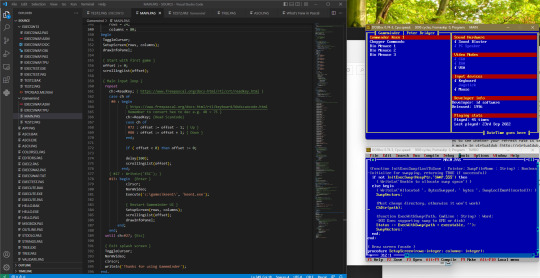#pathminded
Explore tagged Tumblr posts
Text
Unlock the Potential of AI with Essential Tools and Symbolism Texta ai Blog Writer
Symbolic Reasoning Symbolic AI and Machine Learning Pathmind As long as there is access to data, the connectionist approach does not require constant human coding and supervision. Symbolism and Connectionism in AI Artificial Intelligence Difference; The influence of AI at the individual and industrial levels is growing at a rapid pace. Despite the increasing ubiquity of artificial intelligence,…

View On WordPress
0 notes
Text
I'm proud to reveal a first peek at Gameminder
On my retro PCs I typically arrange my various games into groups of directories for specific genres (e.g action, shooter, strategy) however it can still be a bit fiddly scrolling through my games using various DOS commands.
Also when I come to launch a game, I often find that I'd not yet got it configured correctly or that there was a slight issue. For example, the sound effects not working.
All of these minor irritations got me thinking about creating a DOS based games launcher which would bypass these issues by creating a lightweight UI to browse my games and view information about them.
After a little research I decided to use Turbo Pascal 7 to create my launcher, using a combination of DOSBox and VSCode to provide a better IDE whilst compiling and testing in an emulated DOS environment.

I can imagine writing something like this on an actual retro PC in the Turbo Pascal being much more of a challenge! We've certainly been spoilt by using modern intuitive IDEs, large screens and other refinements.
One of the most complex challenges so far was working out how to launch a game without the launcher itself taking up too much memory. Thankfully some other skilled Pascal developers have already solved this issue by writing the current program to EMS or disk and leaving only a 2K stub in conventical RAM to manage the swap in and out of the launched executable.
The UI is modelled on an old DOS utility used to navigate, edit and execute files called PathMinder.

I first came across this on my Dad's XT PC he used at home for work. When I got a 286 EGA PC a few years later, I carried on using and enjoying it.
I know that XTree seemed to be a more popular utility that performed a similar function, however I always preferred PathMinder. To me it was the superior underdog. So I'm creating GameMinder as a kind of tribute.
What's left to do
I'm currently struggling with understanding how to work with arrays of records in Pascal. Unfortunately it seems to be a lot more fiddley than the modern languages that I'm used to!
Once that's out the way, I need to implement the scanning of the file system to find the files in each game directory that will hold information about that game. These will need to be manually maintained and will contain simple text meta data about each game.
With that in place it'll really just be continued refinement of the UI to offer features such as
Ordering of games (Name, release year, most popular)
Playtime statistics (How many times played each game, when last played)
Help (List keyboard commands)
Editor (Setup meta data for each game)
I'll also make the full source code available so that others can extend, improve or just learn from what I've done.
44 notes
·
View notes
Note
So why do themlets exist among moonshadow elves if clothing isn't gendered? And how come the only two moon themlets we know happen to be ghosted by the community?
Themlets? What makes you think all nonbinary Moonshadows are short? *briefly considers a measuring task* Ah, perhaps you're just tall, like me.
I've never thought too much about it, love, but I assume - and feel free to correct me if I'm wrong here - but I assume that nonbinary people exist because they wish to exist, and so that everyone may bask in their amazing presence. I'm certainly blessed by them.
*thoughtful craftsman frown, studies hammer in my hand* Swirlies don't have gender, you know. Doesn't matter how decorative I make the outside of this hammer. It's still a hammer. *Zen smile, lightly taps worktable* See? It was a hammer before I decorated it, and it'll still be a hammer if I file them all off. Ah, please don't ask me to do that, though! My poor swirlies... so pretty... *smooches hammer reassuringly* Don't worry, baby, I wasn't serious.
As for your other question, I'm sure I don't know who you mean. No one has been ghosted from the Silvergrove since Rayla. I've threatened to cry in public if anyone so much as breathes of it, and that terrifies even the hardiest of assassins. Likely because they fear the ghost of Runaan will crack open a fissure from the beyond and swoop back in to avenge me.
Just because you haven't met more nonbinary Moonshadows doesn't mean I haven't! The Silvergrove ambassador to Hollow Wood uses they/them, and so does my hairstylist, and the village eggkeeper, and the pathminder... two of Rayla's former teachers - they married a pair of sisters, it's entirely adorable... literally everyone in Basket End... Oop, I'm already out of fingers, but you get the idea, yes?
If you wish there were more enbies in the Moonshadow Forest, love, then your wish is granted, because they've been there all along.

#ask ethari#just moonshadow things#just gender things#binary is just code#and nonbinary is just cracking it#all elves are queer let them vibe#eljaal get back here you owe me a bushel of star plums#i have never forgotten and i never will i want my plums
19 notes
·
View notes
Text
Digital twins save the New Year

Artificial Intelligence Involved in Solving the Global Logistics Crisis News of global supply chain problems has been around for months - that Christmas gifts may not reach customers on time, dozens of container ships queuing in ports, and retailers trying to find alternative shipping methods. As Joseph Marc Blumenthal writes, one of the ways to cope with this problem may be the proliferation of so-called digital twins. By itself, this technology has been used for several years. The digital twin is a kind of virtual model of a real object, based on artificial intelligence and helping to optimize work. In order for the digital twin to properly reflect reality, it must receive a huge amount of data from its real prototype - this is done using various sensors, cameras and other data sources. With the help of such systems, it is possible to simulate situations in production (or in logistics) and possible disruptions in work. AI can also provide guidance on how to deal with these violations. However, until now, digital twins of limited objects have usually been created - from a single device to a group of enterprises. Now we are talking about digital twins of supply chain systems as a whole - modeling an extremely complex system with numerous suppliers, complex transport networks, etc. According to Hans Thalbauer, managing director of Google's supply chain and logistics division, the main problem for logistics companies is the inability to predict events that may affect supply chains. “Anyone in the supply chain business will tell you that they lack the breadth of vision they need to make decisions,” says Talbauer. It is this latitude that digital twins can provide. If such an AI-based digital twin receives enough data from its physical counterpart, it can replay potential failures over and over again and find the best option through trial and error. The data that the digital twin must receive for normal forecasting is very different. Information about the company itself, its suppliers, their stocks and planned delivery dates, data on consumer behavior based on financial forecasts and market research. And also information about the world as a whole, for example, about the likelihood of natural disasters and the geopolitical situation in different regions. For example, it can test the assumption that Taiwan will experience a drought and water shortages will lead to a reduction in semiconductor production. The digital twin will predict the likelihood of such an event, track its impact on different parts of the supply chain, and suggest options on how to at least mitigate the blow. Even with the use of AI, such analysis is still a very difficult task. So, the automaker Ford has more than 50 factories around the world, annually they use 35 billion parts to produce 6 million cars. These parts come from 1.4 thousand suppliers from 4.4 thousand factories, and in some cases supply chains come into play. A stress test of a system requires checking all its elements and exploring different options - what to do in case of a failure at a particular plant or at a particular supplier. Amazon is already using digital twins for supply chains. Such technologies are being developed by Google, FedEx and DHL. There are also companies specializing in digital twins for logistics systems, such as Pathmind or Deliverr. Pathmind's digital twins work with existing supply chain management tools and data from a particular company. They use this data to model various problems in the system and options for solving problems. According to Pathmind founder Chris Nicholson, the resulting synthetic data - that is, not directly obtained, but generated by AI based on this direct data - helps to predict a variety of scenarios, such as a pandemic, and learn how to minimize their damage to supply chains. “This is the answer to the question: why is AI smart? He just lives longer than we do in all these different worlds, many of which never existed, ”he says. As the head of the data analysis laboratory of the Massachusetts Institute of Technology
David Simchi-Levy notes, one of the important goals of logistics companies with the onset of the pandemic and the crisis was to increase the resiliency of the supply chain, that is, the ability of the system to remain stable and operable in the event of failure of some of its elements. Companies are willing to invest in this, but they want to maintain a balance by strengthening the supply chain enough without spending too much money - and from this point of view, digital twins can also help. “We are seeing more and more companies stress testing their supply chains using digital twins,” says Professor Simchi-Levy. At the same time, experts admit that technology alone will not help here. “Technology will not solve these problems. They won't help ships carry more containers. But digital twins will help us detect problems before they happen, ”says Professor Simchi-Levy. Some elements of supply chains also lag behind in terms of digitizing data. “Many of the world's ports do business on paper, you are very lucky if they use PDF or email. And these are the big operators, not the New Hampshire candle manufacturer. Without digitalization, AI will not be able to work, ”says Mr Nicholson.
0 notes
Text
Embodied AI, superintelligence and the master algorithm
Embodied AI, superintelligence and the master algorithm
Chris Nicholson Contributor Share on Twitter Chris Nicholson is the founder and CEO of Pathmind, a company applying deep reinforcement learning to industrial operations and supply chains. More posts by this contributor UPDATED: Machine learning can fix Twitter, Facebook, and maybe even America Superintelligence, roughly defined as an AI algorithm that can solve all problems better than people,…
View On WordPress
0 notes
Text
Deep Learning Market Size By Manufacturer Growth Analysis, Industry Share, Business Growth and Trends
According to the latest report by IMARC Group, titled “Deep Learning Market: Global Industry Trends, Share, Size, Growth, Opportunity and Forecast 2021-2026,” the global deep learning market exhibited robust growth during 2015-2020. Looking forward, IMARC Group expects the global deep learning market to grow at a CAGR of around 40% during 2021-2026. Deep learning is a subset of machine learning (ML) in the field of artificial intelligence (AI), which imitates the workings of the human brain for processing big data and creating patterns. Also known as a deep neural network, it plays a vital role in data science, which includes statistics and predictive modeling. As a result, deep learning is widely employed in different industries, such as media, finance, medical, aerospace, defense and advertising, across the globe. For instance, it is used in driverless cars for recognizing a stop sign or distinguishing pedestrians from lampposts. Besides this, it assists in controlling consumer devices like tablets, smartphones, televisions and hands-free speakers.
As the novel coronavirus (COVID-19) crisis takes over the world, we are continuously tracking the changes in the markets, as well as the industry behaviours of the consumers globally and our estimates about the latest market trends and forecasts are being done after considering the impact of this pandemic.
Request Free Sample Report: https://www.imarcgroup.com/deep-learning-market/requestsample
Global Deep Learning Market Trends:
The market is currently experiencing growth owing to the expanding applications of deep learning solutions in cybersecurity, database management and fraud detection systems. Additionally, they are employed in the healthcare sector to process medical images for disease diagnosis and offer virtual patient assistance, which in turn is strengthening the market growth. Apart from this, the burgeoning information technology (IT) sector, in confluence with the increasing trend of digitalization, is boosting the sales of deep learning solutions across the globe. Furthermore, the integration of these solutions with big data analytics and cloud computing is bolstering the market growth. Moreover, leading vendors in the industry are focusing on increasing research and development (R&D) activities to introduce improved hardware and software processing technologies for deep learning.
Ask Customization and Browse Full Report with TOC & List of Figure: https://www.imarcgroup.com/deep-learning-market
Competitive Landscape with Key Player:
Amazon Web Services (Amazon.com Inc.)
Google LLC
International Business Machines (IBM) Corporation
Intel Corporation
Micron Technology, Inc.
Microsoft Corporation
Nvidia Corporation
Qualcomm Incorporated
Samsung Electronics Co. Ltd.
Sensory Inc.
Pathmind, Inc.
Xilinx, Inc.
Breakup by Product Type:
Software
Services
Hardware
Breakup by Application:
Image Recognition
Signal Recognition
Data Mining
Others
Breakup by End-Use Industry:
Security
Manufacturing
Retail
Automotive
Healthcare
Agriculture
Others
Breakup by Architecture:
RNN
CNN
DBN
DSN
GRU
Market Breakup by Region:
North America (United States, Canada)
Europe (Germany, France, United Kingdom, Italy, Spain, Others)
Asia Pacific (China, Japan, India, Australia, Indonesia, Korea, Others)
Latin America (Brazil, Mexico, Others)
Middle East and Africa (United Arab Emirates, Saudi Arabia, Qatar, Iraq, Other)
Key Highlights of the Report:
Market Performance (2015-2020)
Market Outlook (2021-2026)
Porter’s Five Forces Analysis
Market Drivers and Success Factors
SWOT Analysis
Value Chain
Comprehensive Mapping of the Competitive Landscape
If you need specific information that is not currently within the scope of the report, we can provide it to you as a part of the customization.
Other Report
United States Running Gear Market: https://www.imarcgroup.com/united-states-running-gear-market
Europe Rechargeable Battery Market: https://www.imarcgroup.com/europe-rechargeable-battery-market
United States Smart Windows Market: https://www.imarcgroup.com/united-states-smart-windows-market
Mobile Application Development Platform Market: https://www.imarcgroup.com/mobile-application-development-platform-market
Styrenic Block Copolymer Market: https://www.imarcgroup.com/styrenic-block-copolymer-market
Teeth Whitening Products Market: https://www.imarcgroup.com/teeth-whitening-products-market
About Us
IMARC Group is a leading market research company that offers management strategy and market research worldwide. We partner with clients in all sectors and regions to identify their highest-value opportunities, address their most critical challenges, and transform their businesses.
IMARC’s information products include major market, scientific, economic and technological developments for business leaders in pharmaceutical, industrial, and high technology organizations. Market forecasts and industry analysis for biotechnology, advanced materials, pharmaceuticals, food and beverage, travel and tourism, nanotechnology and novel processing methods are at the top of the company’s expertise.
Contact Us IMARC Group 30 N Gould St, Ste R Sheridan, WY (Wyoming) 82801 USA Email: [email protected] Tel No:(D) +91 120 433 0800 Americas:- +1 631 791 1145 | Africa and Europe :- +44-702-409-7331 | Asia: +91-120-433-0800, +91-120-433-0800
0 notes
Link
Reinforcement learning in Fortune 1000 companies. RBC Capital Markets -- new trading platform called Aiden, JP Morgan Foreign Exchange (FX) pricing and trading algorithms, Starbucks -- increase engagement on its mobile app, Cisco -- improve customer-facing services, Nike -- build personalization models, Wayfair -- their entire stack of recommenders, Fortinet -- part of their core product offerings, GE -- automated building management systems, Dell -- build storage solutions that can automatically change in response to workloads, Pathmind -- large-scale simulations and optimizations for semiconductors, Google -- chip design, Synopsys -- optimizing chip design, Cadence -- increase throughput and coverage of a formal verification system, and QuantumBlack (part of McKinsey) -- design of the boat used by the winning team of the 2021 America’s Cup.
0 notes
Text
Digital twins seek to solve breakages in the supply chain by anticipating them before they happen and then using AI to figure out a workaround. The name captures the key idea of simulating a complex system in a computer, creating a kind of twin that mirrors real-world objects—from ports to products—and the processes they are a part of. Simulations have been a part of decision-making in industry for some years, helping people explore different product designs or streamline the layout of a warehouse. But the availability of large amounts of real-time data and computing power means that more complex processes can be simulated for the first time, including the chaos of global supply chains that often rely on numerous vendors and transportation networks.
This kind of technology has given Amazon, which already has the advantage of controlling its own trucks and warehouses, an extra edge for years. Now others are embracing it as well. Google is developing supply-chain digital twins that the car maker Renault announced it had started using in September. International shipping giants like FedEx and DHL are building their own simulation software. And AI firms like Pathmind are creating bespoke tools for anyone who can pay for them. Yet not everyone will benefit. In fact, the powerful new technology could widen a growing digital divide in the global economy.
5 notes
·
View notes
Photo

Simulation and Automated Deep Learning http://ehelpdesk.tk/wp-content/uploads/2020/02/logo-header.png [ad_1] AnyLogic AI - https://www.anylog... #ai #androiddevelopment #angular #anylogic #arashmahdavi #automateddeeplearning #automl #c #css #dataanalysis #datascience #deeplearning #development #docker #drl #eduardogonzalez #iosdevelopment #java #javascript #machinelearning #node.js #pathmind #python #react #simulation #skymind #unity #webdevelopment #webinar
0 notes
Text
5 ways companies adapt to the lack of data scientists

Where are all the data scientists? Coping with the data scientist shortage is a struggle for many enterprises. Here are five ways to effectively manage with the shortage. As enterprises establish data-centric cultures for decision-making and planning, data scientists continue to grow in importance to businesses around the world. But organizations can't hire data scientists fast enough, as the field of qualified candidates remains highly constrained. In order to cope with this data scientist shortage, enterprises are taking a variety of approaches to get as much as they can from the few data professionals they can find and retain. Automation A lot of the work typically done by data scientists is focused on data management and operational tasks like identifying data sources, merging data sets and validating data quality. These tasks are not the high-value work that data scientists are generally hired to do. That's changing as more automation efforts comes into the enterprise. "Model development, as well as model operationalization, can be significantly simplified by automation," said Ryohei Fujimaki, CEO and founder of DotData, an automated machine learning (ML) software company based in San Mateo, Calif. "New data science automation platforms will enable enterprises to deploy, operate and maintain data science processes in production with minimal efforts, helping companies maximize their AI and ML investments and their current data team." According to Matthew Baird, founder and CTO of AtScale, an automated data engineering software company, some of the most promising developments in data science automation are in the area of autonomous data engineering, which automates data management and handling tasks. "Such advances come in the form of 'just-in-time' data engineering -- automation that essentially acts like the perfect data engineering team if they had all that knowledge and complete input to data handling," Baird said, "including understanding how to best leverage underlying data structures of various databases, their unique network characteristics, data location, native security setup and policies."

Automation is the next step for advancements in business analytics. Emphasizing self-service analytics All this added data management and modeling automation is meant to not only serve to get the most out of senior data scientists but also democratize data resources for citizen data scientists. Scaling out data exploration with self-service analytics is another popular method of dealing with the data scientist shortage. "The combination of autonomous data engineering advances and the increasing enablement of citizen analysts via self-service analytics are freeing valuable data science and data engineering resources to focus on higher-value activities such as building the next in machine learning or artificial intelligence models," Baird said. Creating cross-functional teams At the same time, enterprises are bumping into the limits of self-service analytics tooling and automation. "Every tool that simplifies data science also limits the flexibility and options of the users, which means that certain complex tasks requiring customization are impossible," said Chris Nicholson, founder and CEO of Pathmind, a deep learning software company. Nicholson believes this reality has led many companies exploring new team strategies to get more out of their limited data experts. "Many companies respond to the scarcity of data scientists by creating cross-functional data science teams that work with many business units across an organization or by hiring external consultants," Nicholson said. "Often what limits the value of data science in an organization is not the scarcity of data scientists themselves but the data that the organization gathers and how it lets people access and process that data." Cross-functional teams can help companies get around fragmented data silos that have been created due to technical and internal political hurdles that can be overcome when the right stakeholders work together in the same teams, Nicholson said. This can also alleviate a common problem that looks like a data scientist shortage but is even more fundamental -- namely that too many data science projects look unmanageable because they have no clear path to business value. "Too many projects are wild goose chases where you throw a bunch of data to the data scientists and say, 'See what you can make of this,'" said Sten Vesterli, principal consultant at More Than Code, an IT consulting firm based in Denmark. "We've seen more than 80% of all data science projects fail to move from the lab into production code, and companies need to allocate their data scientist to the most high-value business goal." Defining data science roles better One of the big issues impeding effective recruitment of data scientists is that enterprises are making the data science title and role far too broad, said Amy Hodler, director of graph analytics and AI programs at graph database company Neo4j. "This makes it difficult to find the right fit for any organization and means new employees have a harder time understanding and aligning to business objectives," Hodler said. She believes that in the coming year, many organizations will start diversifying their data science-related titles, creating subcategory job focuses and more tightly focused job requirements. Internal training Hodler also believes the market will start responding to the data scientist shortage this year with more internal training of existing employees who exhibit any potential or desire to pivot into data science. This is going to be a hit-or-miss tactic, as organizations will have to be strategic about the specific skills they nurture in their budding data scientists, she said. "A long-view mindset is required to clearly evaluate and define required skill sets in a way that balances not just the tools/approaches that are hot today but also investing in core concepts that can be built upon for years ahead," Hodler said. "Pairing junior and senior data scientists will become crucial to evolving and retaining these employees for the next few years." This article has been published from a wire agency feed without modifications to the text. Only the headline has been changed. Source link Read the full article
0 notes
Text
Skymind Global Ventures launches $800M fund and London office to back AI startups
Skymind Global Ventures (SGV) appeared last year in Asia/US as a vehicle for the previous founders of a YC-backed open-source AI platform to invest in companies that used the platform.
Today it announces the launch of an $800 million fund to back promising new AI companies and academic research. It will consequently be opening a London office as an extension to its original Hong Kong base.
SGV Founder and CEO Shawn Tan said in a statement: “Having our operations in the UK capital is a strategic move for us. London has all the key factors to help us grow our business, such as access to diverse talent and investment, favorable regulation, and a strong and well-established technology hub. The city is also the AI growth capital of Europe with the added competitive advantage of boasting a global friendly time zone that overlaps with business hours in Asia, Europe and the rest of the world.”
SGV will use its London base to back research and development and generate business opportunities across Europe and Asia.
The company helps companies and organizations to launch their AI applications by providing them supported access to “Eclipse Deeplearning4j”, an open-source AI tool.
The background is that the Deeplearning4j tool was originally published by Adam Gibson in late 2013 and later became a YC-backed startup, called Pathmind, which was cofounded to commercialize Deeplearning4j. It later changed its name to Skymind.
SGV is a wholly separate investment company that Adam Gibson joined as VP to run its AI division, called Konduit. Konduit now commercializes the Deeplearning4j open source tools.
Adam Gibson now joins SGV as Vice President, to run its software division, Konduit, which delivers and supports Eclipse Deeplearning4j to clients, as well as offering training development.
SGV firm says it plans to train up to 200 AI professionals for its operations in London and Europe.
In December last year “Skymind AI Berhad”, the Southeast Asia arm of Skymind and Huawei Technologies signed a Memorandum of Understanding to develop a Cloud and Artificial Intelligence Innovation Hub, commencing with Malaysia and Indonesia in 2020.
from RSSMix.com Mix ID 8204425 https://ift.tt/2vxZnHj via IFTTT
0 notes
Link
Article URL: https://announcement.pathmind.com/skymind-is-now-pathmind/
Comments URL: https://news.ycombinator.com/item?id=21817976
Points: 5
# Comments: 0
0 notes
Photo

Just a midweek reminder for us to trust the timing of our lives + journeys. Happy Hump day guys! ✌🏿️❤️🌞 ~Chels #Pathminded #TheCoffeyBreak
0 notes
Text
Skymind Global Ventures launches $800M fund and London office to back AI startups
Skymind Global Ventures (SGV) appeared last year in Asia/US as a vehicle for the previous founders of a YC-backed open-source AI platform to invest in companies that used the platform.
Today it announces the launch of an $800 million fund to back promising new AI companies and academic research. It will consequently be opening a London office as an extension to its original Hong Kong base.
SGV Founder and CEO Shawn Tan said in a statement: “Having our operations in the UK capital is a strategic move for us. London has all the key factors to help us grow our business, such as access to diverse talent and investment, favorable regulation, and a strong and well-established technology hub. The city is also the AI growth capital of Europe with the added competitive advantage of boasting a global friendly time zone that overlaps with business hours in Asia, Europe and the rest of the world.”
SGV will use its London base to back research and development and generate business opportunities across Europe and Asia.
The company helps companies and organizations to launch their AI applications by providing them supported access to “Eclipse Deeplearning4j”, an open-source AI tool.
The background is that the Deeplearning4j tool was originally published by Adam Gibson in late 2013 and later became a YC-backed startup, called Pathmind, which was cofounded to commercialize Deeplearning4j. It later changed its name to Skymind.
SGV is a wholly separate investment company that Adam Gibson joined as VP to run its AI division, called Konduit. Konduit now commercializes the Deeplearning4j open source tools.
Adam Gibson now joins SGV as Vice President, to run its software division, Konduit, which delivers and supports Eclipse Deeplearning4j to clients, as well as offering training development.
SGV firm says it plans to train up to 200 AI professionals for its operations in London and Europe.
In December last year “Skymind AI Berhad”, the Southeast Asia arm of Skymind and Huawei Technologies signed a Memorandum of Understanding to develop a Cloud and Artificial Intelligence Innovation Hub, commencing with Malaysia and Indonesia in 2020.
0 notes
Photo

“18 Do not remember the former things, Nor consider the things of old. 19 Behold, I will do a new thing, Now it shall spring forth; Shall you not know it? I will even make a road in the wilderness And rivers in the desert. Isaiah 43:18-19 He can always make a way out of no way. Always. It's just the waiting part that sucks sometimes. I'm celebrating quite a few little wins this morning, and standing firm on a few others. What matters most is that things from the past could possibly be the very source blocking me from that breakthrough if not handled appropriately emotionally, spiritually, etc. Never risk the magic. Let it take its time. Have a great week you guys! ✌🏿️❤️🌞 ~Chels #trusttheprocess #PathMinded #TheCoffeyBreak (at Hope City)
1 note
·
View note
Photo

💯🙈 It's just so true haha Getting ready for this morning's study hall for #entrepreneurs. Accountability really does make all the difference. Can't wait to see everyone! Happy Saturday you guys! ✌🏿️❤️🌞 ~Chels #hopecity #connectgroup #PathMinded #TheCoffeyBreak (at Ronin Art House)
0 notes